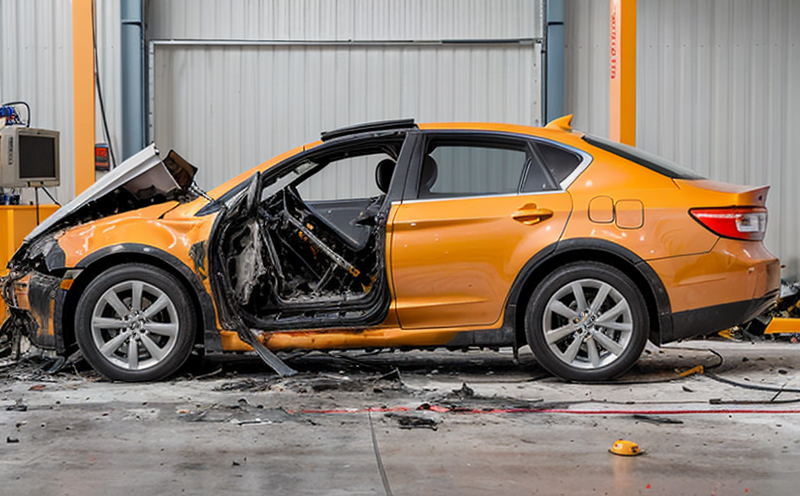IEEE 1625 Mechanical Shock Testing of Rechargeable Battery Systems for Portable Computers
The IEEE Standard 1625-2018, “Mechanical Abuse and Crash Testing of Rechargeable Battery Systems for Portable Computing Devices,” provides a comprehensive framework for ensuring the robustness and safety of rechargeable battery systems used in portable computers. This standard is crucial for manufacturers, compliance officers, quality managers, and R&D engineers who need to ensure that batteries meet rigorous mechanical abuse criteria before deployment.
The IEEE 1625 test focuses on simulating real-world conditions where a battery might experience mechanical shock or impact. This can include drops from various heights, vibrations, or impacts during transportation or use. By subjecting the battery to these controlled tests, manufacturers can identify potential weaknesses and improve product safety.
The standard specifies four primary types of mechanical abuse tests:
- Drop Test: The battery is dropped from a specified height onto a hard surface.
- Vibration Test: The battery undergoes controlled vibration to simulate the effects of transport and handling.
- Impact Test: The battery experiences a sudden force, simulating an accidental impact.
- Shock Test: The battery is exposed to a rapid change in acceleration.
Each test has precise parameters that must be adhered to for accurate results. For instance, the drop height can range from 15 cm to 200 cm, depending on the battery type and size. Vibration tests typically last between 30 seconds to 60 minutes, with specific frequency ranges and amplitudes.
The testing process involves detailed specimen preparation. Batteries must be fully charged or discharged as specified in the standard, ensuring that any potential effects of charge state are accounted for during testing. After each test, the battery is visually inspected for damage. If no visible damage is observed, further internal checks may be conducted to ensure structural integrity.
The IEEE 1625-2018 standard is widely recognized and adopted by major manufacturers in the portable computing industry. Compliance with this standard ensures that products are reliable under real-world conditions. It also helps in meeting regulatory requirements across various regions, thereby reducing the risk of recalls and product liability issues.
By incorporating IEEE 1625 testing into their quality assurance processes, companies can enhance consumer trust and satisfaction. Additionally, successful compliance with this standard can provide a competitive edge by demonstrating a commitment to safety and reliability.
Why Choose This Test
- Compliance Assurance: Ensures adherence to international standards, reducing the risk of non-compliance penalties.
- Risk Mitigation: Identifies potential weaknesses in battery design before they become safety hazards.
- Enhanced Consumer Trust: Demonstrates a commitment to product safety and reliability.
- Regulatory Compliance: Meets the requirements of various regulatory bodies worldwide.
- Competitive Advantage: Enhances brand reputation and market credibility.
- Cost Efficiency: Identifies and rectifies issues early in the development process, reducing potential costs associated with later recalls or product failures.
Environmental and Sustainability Contributions
The IEEE 1625-2018 standard plays a significant role in promoting environmental sustainability by ensuring that rechargeable batteries used in portable computers are robust against mechanical abuse. This reduces the likelihood of battery failures during use, thereby extending product lifespan. The standard also encourages manufacturers to design products with durability in mind, leading to reduced waste and extended operational life.
By adhering to this standard, companies contribute positively to environmental sustainability by minimizing resource consumption and reducing electronic waste. This aligns with broader sustainability goals set by organizations such as the United Nations Environment Programme (UNEP) and various national green initiatives.
Use Cases and Application Examples
| Test Case | Description |
|---|---|
| DROP TEST AT 150 CM | The battery is dropped from a height of 1.5 meters onto a concrete surface. After the test, the battery is visually inspected for any cracks or visible damage. |
| VIBRATION TEST AT 40 HZ | The battery undergoes controlled vibration at 40 Hz for 60 minutes. The amplitude is set to 2 mm peak-to-peak. Post-test inspection checks for any internal or external damage. |
| IMPACT TEST AT 15 KGS | The battery is subjected to a sudden impact of 15 kg onto its top surface. The impact is delivered at an angle of 45 degrees. Visual inspection follows. |
| SHOCK TEST AT 20 G | The battery experiences a rapid change in acceleration from zero to 20 g and back to zero within one second. The battery is inspected for any cracks or visible damage. |
| Test Case | Description |
|---|---|
| DROP TEST AT 200 CM | The battery is dropped from a height of 2 meters onto a hard surface. Inspection for internal and external damage follows. |
| VIBRATION TEST AT 60 HZ | The battery undergoes controlled vibration at 60 Hz for 30 minutes, with an amplitude of 1.5 mm peak-to-peak. Visual inspection is conducted post-test. |
| IMPACT TEST AT 20 KGS | The battery experiences a sudden impact of 20 kg at a 60-degree angle. Inspection for any damage follows. |
| SHOCK TEST AT 30 G | The battery undergoes a rapid change in acceleration from zero to 30 g and back to zero within one second. Visual inspection is conducted post-test. |





